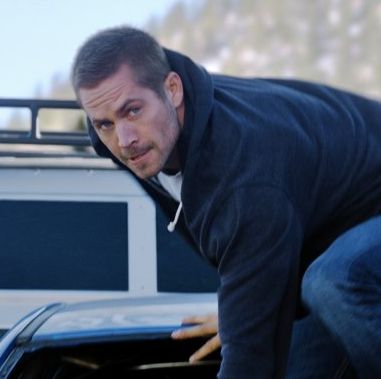
Furious 7 provides a fitting big-screen farewell for actor Paul Walker, but until the film stormed South by Southwest last night with a surprise midnight screening, questions still persisted about just how much of the latest Fast & Furious sequel he’d appear in. The Furious 7 shoot was just over halfway done when Walker perished in a crash crash in November 2013, necessitating a production shutdown and release-date delay as studio executives, producers, and director James Wan figured out how to reconfigure the film around the footage of Walker they’d managed to get. Would crucial scenes have to go missing in the final cut? Would Walker’s character, Brian O’Conner, disappear from the narrative for large, noticeable chunks of time? Of all the impossible stunts this franchise has had to pull off over its seven-film duration, stitching together Furious 7 without the full participation of its co-lead surely entailed the highest degree of difficulty.
Here’s the shocking thing (yes, even more shocking than that death-defying car drop that is the centerpiece of Furious 7’s marketing campaign): By and large, the filmmakers pulled it off. The casual observer might not even notice anything amiss while watching Furious 7, since Walker’s Brian remains a crucial character who takes part in every one of the film’s significant sequences and has his own complete emotional arc besides. No one would first call the Fast & Furious films elegantly written, but the way the filmmakers have almost seamlessly integrated Walker into the final product — even incorporating an emotional sendoff for his character that feels organic — is nothing less than impressive.
That said, things do get off to a somewhat shaky start. In Brian’s second scene, the film is clearly deploying doubles for Walker — two of whom were played by the actor’s own look-alike brothers — as Vin Diesel’s Dom and Jordana Brewster’s Mia discuss Brian’s future while the character remains conspicuously out of frame during nearly the entire sequence. Mostly, Brian is glimpsed from the back while playing with his son; in fact, the only full-on shot of Walker comes at the end of the scene, and it’s filtered through woozy smoke that was doubtlessly used to obscure the computer-generated face graft.
There are a few more suspicious moments much later on in the film — Brian’s big third-act fight sequence is a dark, quick-cut affair that lacks even a single medium shot of Walker’s face, and the coda that closes out his character arc contains a handful of uncanny-valley shots that veer close to Livia Soprano territory — but on the whole, Furious 7 manages to stick its tricky landing. It helps, of course, that the movie has a deep, appealing ensemble cast to lean on: When the gang goes to Abu Dhabi for an outdoor shoot that Walker was not present for, you’ll hardly notice Brian standing wordlessly in the background as the other characters do their thing. And while Diesel carries most of the movie’s heft (and its screen time) on his impressive shoulders, that’s pretty much par for the course in this series, where Walker always functioned best as the solid straight man.
Still, there can be no doubt that Furious 7’s emotional takeaway belongs to Walker. It’s almost eerie how Brian’s character arc in this film poignantly parallels Walker’s real life: As Brian finds himself torn between the high-adrenaline driving he loves and the family life (complete with young son) he jeopardizes by taking part in those dangerous races, it’s hard not to think about Walker’s own daughter, left behind after the actor’s tragic death. And whether it’s due to serendipity or some well-finessed rewrites, the characters in Furious 7 all get to say a meaningful good-bye to Walker, culminating in a sendoff shot that’s downright simple and poetic — two words not often used when discussing these films, but two words nevertheless surpassed by the two you’ll then see in the movie’s final onscreen dedication: “FOR PAUL.”

